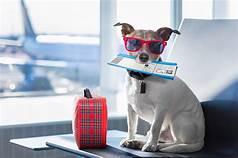How to Fly with Your Pet
Traveling with your pet can be a bonding experience, but it can also be a challenge, especially if you're flying. With a little planning and preparation, however, you can make the trip as smooth and stress-free as possible for both you and your furry friend.

Tips for Flying with Your Pet
1. Choose the Right Airline
Not all airlines allow pets, and those that do have different policies regarding the size, weight, and breed of animals that they will transport. Do your research before booking your flight to make sure that your airline of choice will accommodate your pet.
2. Get Your Pet's Health Checked
Before you can travel with your pet, you will need to get a health certificate from your veterinarian. This certificate must state that your pet is healthy and fit to fly.
3. Prepare Your Pet's Travel Crate
Your pet must travel in a crate that is large enough for them to stand up, turn around, and lie down comfortably. The crate must also be well-ventilated and have a solid bottom. You should accustom your pet to the crate before the flight by placing it in your home and letting them explore it.
4. Pack Your Pet's Essentials
In addition to your pet's travel crate, you will also need to pack their food, water, a leash, and a few toys. You should also bring a copy of your pet's health certificate and vaccination records.
5. Arrive at the Airport Early
When you arrive at the airport, you will need to check in your pet's travel crate at the airline's cargo counter. You will also need to pay any required fees. It's a good idea to arrive at the airport at least two hours before your flight is scheduled to depart.
6. Stay Calm and Be Patient
Flying can be a stressful experience for pets, so it's important to stay calm and be patient throughout the process. Talk to your pet in a soothing voice and try to keep them comfortable. If your pet is anxious, you can give them a pet-safe sedative before the flight.
Additional Tips
1. Consider flying your pet in the cabin with you.
If your pet is small enough, you may be able to fly them in the cabin with you. This is a good option if you're worried about your pet being stressed or anxious in cargo.
2. Book a non-stop flight.
If possible, book a non-stop flight to avoid any potential delays or complications.
3. Bring a pet carrier on board with you.
Even if your pet is flying in cargo, you can bring a pet carrier on board with you. This will give your pet a place to rest and feel comfortable during the flight.
4. Be prepared for delays.
Flight delays can happen, so it's important to be prepared. Pack enough food and water for your pet in case of a delay.
5. Know your pet's temperament.
If your pet is anxious or aggressive, you may need to make special arrangements for their flight. Talk to your veterinarian about your options.
Declaration: All article resources on this website, unless otherwise specified or labeled, are collected from online resources. If the content on this website infringes on the legitimate rights and interests of the original author, you can contact this website to delete it.





